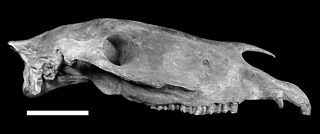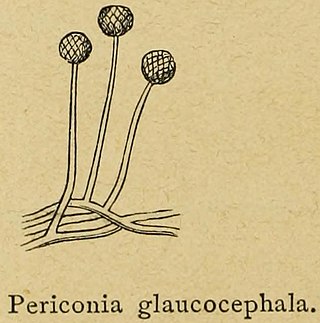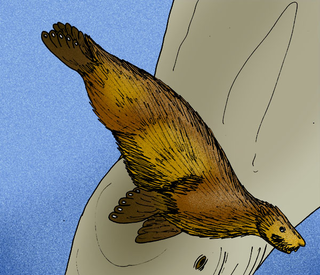
The earless seals, phocids, or true seals are one of the three main groups of mammals within the seal lineage, Pinnipedia. All true seals are members of the family Phocidae. They are sometimes called crawling seals to distinguish them from the fur seals and sea lions of the family Otariidae. Seals live in the oceans of both hemispheres and, with the exception of the more tropical monk seals, are mostly confined to polar, subpolar, and temperate climates. The Baikal seal is the only species of exclusively freshwater seal.

Placozoa is a phylum of marine and free-living (non-parasitic) animals. They are simple blob-like animals without any body part or organ, and are merely aggregates of cells. Moving in water by ciliary motion, eating food by engulfment, reproducing by fission or budding, placozoans are described as "the simplest animals on Earth." Structural and molecular analyses have supported them as among the most basal animals, thus, constituting the most primitive metazoan phylum.

Diadectomorpha is a clade of large tetrapods that lived in Euramerica during the Carboniferous and Early Permian periods and in Asia during Late Permian (Wuchiapingian), They have typically been classified as advanced reptiliomorphs positioned close to, but outside of the clade Amniota, though some recent research has recovered them as the sister group to the traditional Synapsida within Amniota, based on inner ear anatomy and cladistic analyses. They include both large carnivorous and even larger herbivorous forms, some semi-aquatic and others fully terrestrial. The diadectomorphs seem to have originated during late Mississippian times, although they only became common after the Carboniferous rainforest collapse and flourished during the Late Pennsylvanian and Early Permian periods.

Low's squirrel is a species of rodent in the family Sciuridae. It is found in Borneo and nearby islets. Its former subspecies S. l. robinsoni from Sumatra and the Malay Peninsula and S. l. natunensis from the Natuna islands have recently been given species status.

Rosellinia is a genus of fungi in the family Xylariaceae consisting of over 90 species. Several of the species in this genus are plant pathogens. Fossils of Rosellinia have been found in 12 million year old rocks from central England.

Haringtonhippus is an extinct genus of equine from the Pleistocene of North America The genus is monospecific, consisting of the species H. francisci, initially described in 1915 by Oliver Perry Hay as Equus francisci. Members of the genus are often referred to as stilt-legged horses, in reference to their slender distal limb bones, in contrast with those of contemporary "stout legged" caballine true horses.

Tulostoma is a genus of fungi in the family Agaricaceae. Species in the genus are commonly known as stalkballs, or stalked puffballs. Fossils of Tulostoma have been reported from 12 million year old rocks in central England and 13.5 million year old coals from Slovakia.

Equus neogeus is an extinct species of equine native to South America during the Pleistocene. It was formerly thought to be several distinct species within the subgenus Amerhippus, but was later shown to be a single morphologically variable species. It is thought to be closely related to true horses.

Gruimorphae is a clade of birds that contains the orders Charadriiformes and Gruiformes identified by molecular analysis. This grouping has had historical support, as various charadriiform families such as the families Pedionomidae and Turnicidae were classified as gruiforms. It may also have support from the fossil record since the discovery of Nahmavis from the Early Eocene of North America.

Periconia is a genus of sac fungi in the order Pleosporales. Fossils of Periconia have been reported from 12 million year old rocks from central England.

Pinnipedimorpha is a clade of arctoid carnivorans that is defined to include the last common ancestor of Phoca and Enaliarctos, and all descendants of that ancestor. Scientists still debate on which lineage of arctoid carnivorans are the closest relatives to the pinnipedimorphs, being more closely related to musteloids.

Hoilungia is a genus that contains one of the simplest animals and belongs to the phylum Placozoa. Described in 2018, it has only one named species, H. hongkongensis, although there are possible other species. The animal superficially resembles another placozoan, Trichoplax adhaerens, but genetically distinct from it as mitochondrial DNA analysis revealed.
Polyplacotoma mediterranea is a species in the phylum Placozoa, only representative of the genus Polyplacotoma. They differ greatly from other species of placozoans with regards to their morphology and genetic makeup, and have been ranked in the separate class Polyplacotomia. P. mediterranea has the smallest mitogenome, the lowest GC content, and the smallest intergenic spacer regions of all placozoans. Their bodily structure consists of elongated polytomous body branches, as well as a maximum size that is greater than 10 mm in length. The mitochondrial genome of Polyplacotoma mediterranea is also very compact and contains overlapping protein and tRNA gene codes.
Fortipesavis is a genus of enantiornithine bird from the Late Cretaceous (Cenomanian) of Myanmar. The genus contains a single species, Fortipesavis prehendens, known from the holotype (YLSNHM01001), a mold of digits II–IV and a partial left tarsometatarsus preserved in amber.

Uniplacotomia is a class of placozoans encompassing the vast majority of the phylum, with the exception of Polyplacotoma. It was established in 2022. It comprises the orders Trichoplacea, Cladhexea and Hoilungea. Their morphology is consistent across the class, resembling the typical Trichoplax as mostly rounded, flat organisms rather than the polytomous, branching structure exhibited by Polyplacotomia.

Cladtertia is a genus of placozoan discovered in 2022, whose only currently described species is Cladtertia collaboinventa. However, the genus is known to contain several other species, awaiting a formal description. Its closest described relative is Hoilungia hongkongensis, with whom it forms the order Hoilungea. After Trichoplax, Hoilungia and Polyplacotomia, it is the fourth described placozoan genus up to date.
Hoilungea is a recently created placozoan order comprising Cladtertia, Hoilungia, and other yet-undescribed species. Named in 2022, it is believed to be sister to Cladhexea, and corresponds to Clades III, IV, V and VII of the literature.
Cladhexea is a recently created placozoan order comprising yet-undescribed species. Named in 2022, it is believed to be sister to Hoilungea, and corresponds to Clade VI of the literature.
Hoilungidae is a recently created placozoan family comprising Hoilungia and other yet-undescribed species. Named in 2022, it is believed to be sister to Cladtertiidae, and corresponds to Clades IV, V and VII of the literature.











